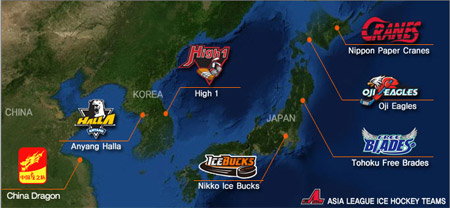Legends
home
From a desert, from the driest continent, from this land at the opposite end of the globe ...
... as remote as could be in the hockey world ...
... came one of the world’s oldest winter sports trophies.
A cool tradition, a dream of champions, and a story we owe it to our children to tell.
Legends of Australian Ice.
Asian Tiger II
Australian hockey goes pro, home and away.
More than two million Australians have an Asian heritage yet Australian sport in Asia has had a long but limited history — cricket on the Indian subcontinent, for example. But it took a step forward recently when Australia joined the Asian Football Confederation (AFC), and our place probably won't ever be the same after the Asian Cup comes here in 2015.
Australia's membership of the AFC has opened more doors to regular contact with most countries in Asia. Our top-10 trading partners will be participating, including Japan, China and South Korea, the member-nations of Asia League Hockey. Developments such as this drive home the happy fact that many industry leaders in Australia and Asia already have close connections to sport through board appointments or team ownership.
 Asia League Hockey
Asia League Hockey
Organisers here are busy facilitating existing business networks and working with government to forge new links between Australian businesses and their Asian counterparts. The focus is on practical programs such as business matching, which enables export-ready businesses to meet carefully-matched potential customers, clients, suppliers, investors and partners with the aim of starting business negotiations right away. The Asian Cup has attracted sponsorship from some of the country's biggest corporations including Emirates, Toshiba, Samsung, Toyota and Minolta. And why not? It has a predicted television reach of 2.5 billion people. Over one-third of the world.
All around the world, the revenue for sporting organisations and events is provided by business sponsors in exchange for a chance to promote their brand. Yet sponsorship in Australia differs from other western economies. Here we are most reliant on car, alcohol and government sponsorship, while overseas it's the financial and telecommunications sectors. Perhaps that is because of the relatively small market here, or perhaps it reflects consumer spending priorities and the small market tendency toward over-reliance on assistance. Whatever the reason, the financial service sector is by far the dominant player in sponsorship in most countries, typically accounting for between 20% and 25% of total spend. Yet, it is almost half that in Australia and the telecommunications sector here is worth just 5.6% of the total.
The business sectors with traditional interest in sport sponsorship will soon have to position themselves for the emergent Asia market. Take the case of the ANZ Banking Group. It's sponsorship portfolio includes the Australian Open and the Shanghai Rolex Masters. The latter helped the bank secure the naming rights to the China Tennis Development Program, a grassroots initiative aimed at developing young talent and supporting the growth of tennis in China. Li Na's recent Australian Open women's final victory is being called the first great sporting win of the "Asian century" and economists say it could open up multi-billion dollar opportunities for Australian companies. And all this is happening, of course, because of the new emergent affluence of young Asians.
ANZ is the main bank from our big four with a clear Asia strategy. It includes obtaining a banking licence in China and seeking additional tennis sponsorship opportunities in Asia. ANZ gave up its naming rights deal with the Ladies Masters in 2011 and is now also interested in finding a golf sponsorship in Asia, where women's golf has also grown in popularity due to good performances by local players.
Big brands tend to be more interested in the global events within the region, yet the big new opportunities will arise in its domestic leagues and sporting bodies. Their infrastructure and funding is relatively limited, and so brands can establish themselves early in the hearts and minds of both participants and fans through supporting the growth of sport. Asian League Hockey is a pro league that is well-positioned to do just that. Although little is written about it in English, the ALH is in a more advanced state than the AIHL. It provides a glimpse of the future.
There are now new opportunities to partner the ALH and business sponsors among the increasingly affluent 1.5 billion people who comprise the East Asia market. Although not huge, the hockey facilities there are better than anything dedicated to ice hockey in Australia and so is the TV and other media partnerships. The smaller rinks such as Nikko Kirifuri Ice Arena in Japan hold 1,600 people, but most are larger. Kushiro Ice Arena in Japan holds 2,500 and the Hakucho Arena there holds 4,000. Mokdong Ice Rink in Seoul seats 5,000 and Anyang Sports Complex there seats 5,000 to 10,000. Songjiang University Arena in Shanghai seats 8,400.
 ALH Ice Arenas
ALH Ice Arenas
An Australian team competing in the ALH in our off-season serves as a good example of an Asia Pacific hockey partnership, no matter how far-fetched it may seem to some. A team would require less resources based there than in Europe or North America, and it is far more likely to attract the required funding through business sponsorship there than home alone. It would return to sponsors a much greater promotional benefit from the world's fastest growing consumer market, and inestimable synergies and spin-offs for the sport throughout the Asia-Pacific.
![]()
1. Sponsorship Today, 2013, a detailed analysis of sponsorship in Australian and New Zealand sport.
2. Wikipedia article, Asia League Ice Hockey
